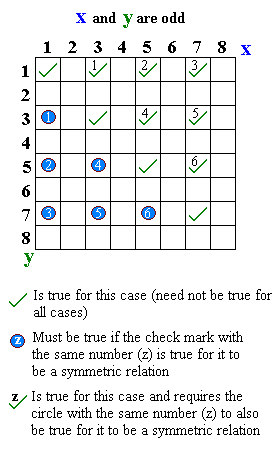Symmetric relation
This article needs additional citations for verification. (July 2021) |
A symmetric relation is a type of binary relation. An example is the relation "is equal to", because if a = b is true then b = a is also true. Formally, a binary relation R over a set X is symmetric if:
If RT represents the converse of R, then R is symmetric if and only if R = RT.[citation needed]
Symmetry, along with reflexivity and transitivity, are the three defining properties of an equivalence relation.[1]
Examples[]
In mathematics[]
- "is equal to" (equality) (whereas "is less than" is not symmetric)
- "is comparable to", for elements of a partially ordered set
- "... and ... are odd":
Outside mathematics[]
- "is married to" (in most legal systems)
- "is a fully biological sibling of"
- "is a homophone of"
- "is co-worker of"
- "is teammate of"
Relationship to asymmetric and antisymmetric relations[]
By definition, a nonempty relation cannot be both symmetric and asymmetric (where if a is related to b, then b cannot be related to a (in the same way)). However, a relation can be neither symmetric nor asymmetric, which is the case for "is less than or equal to" and "preys on").
Symmetric and antisymmetric (where the only way a can be related to b and b be related to a is if a = b) are actually independent of each other, as these examples show.
| Symmetric | Not symmetric | |
| Antisymmetric | equality | "is less than or equal to" |
| Not antisymmetric | congruence in modular arithmetic | "is divisible by", over the set of integers |
| Symmetric | Not symmetric | |
| Antisymmetric | "is the same person as, and is married" | "is the plural of" |
| Not antisymmetric | "is a full biological sibling of" | "preys on" |
Properties[]
- A symmetric and transitive relation is always quasireflexive.[citation needed]
- A symmetric, transitive, and reflexive relation is called an equivalence relation.[1]
- One way to conceptualize a symmetric relation in graph theory is that a symmetric relation is an edge, with the edge's two vertices being the two entities so related. Thus, symmetric relations and undirected graphs are combinatorially equivalent objects.[citation needed]
References[]
- ^ Jump up to: a b c Biggs, Norman L. (2002). Discrete Mathematics. Oxford University Press. p. 57. ISBN 978-0-19-871369-2.
See also[]
- Commutative property – Property allowing changing the order of the operands of an operation
- Symmetry in mathematics – Symmetry in mathematics
- Symmetry – Mathematical invariance under transformations
- Binary relations
- Symmetric relations













